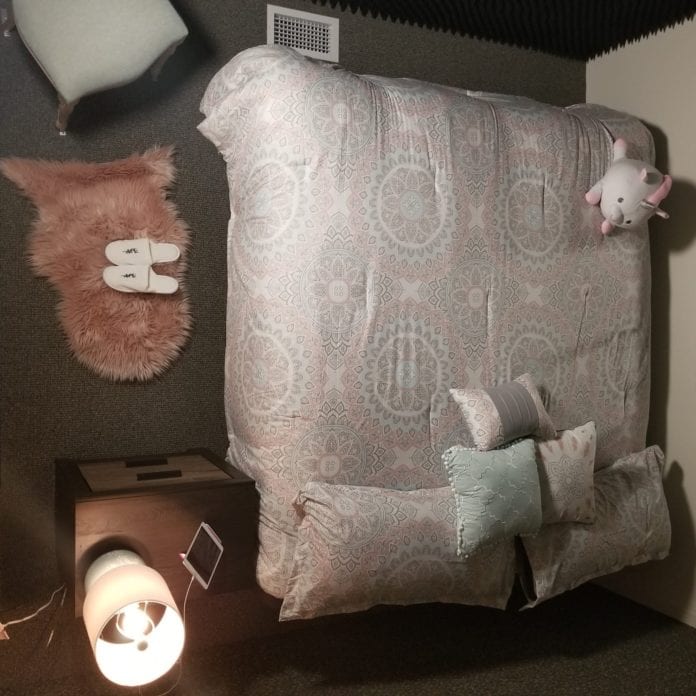In a tucked-away corner of Verizon’s Fios network nerve center, there is a tween girl’s dream bedroom: a double bed with a posh gray-and-white bedspread, complete with a collection of fashionable matching pillows and a comically round stuffed unicorn. A framed drawing of a black-and-white elephant splashed with pink overlooks a fluffy pink rug, on which a pair of monogrammed white slippers rest.
But this entire slice of trendy decor — bed, side table, chair, rug and all, right down to the slippers — is mounted to a vertical wall, looming upwards and defying gravity. Encountering it is a bit like stepping into a cozily modern version of an MC Escher painting, or perhaps an art installation meant to illustrate the world being turned upside down — or at least, sideways. Sideways is, in fact, the whole point of the room, because this is Verizon’s Sideways House.
When a company tests how well their residential Wi-Fi access points work, they want to replicate the home environment as closely as possible, right down to building materials and furniture. Often that means renting or purchasing a more-or-less typical suburban home to use as a test house. Some even outfit the house with tracks on which device-equipped test robots can run, to assess device and network performance as a user moves from room to room.
Verizon took a different approach to its home Wi-Fi testing facility: it designed a space that replicated a three-story house, but flipped the entire thing on its side. Sideways House resides within Verizon’s Fios Network Management Center in northern Virginia, a sleek, imposing business center so enormous that it brings to mind an international airport, cavernous hallways and all. The 4,500-square-foot Sideways House is a relatively small portion of the NMC, but an important piece of Verizon’s service to about 6.3 million Fios customers.
Cellular device testing and assessing cellular network performance is old hat for Verizon — but providing residential Wi-Fi for its Fios customers is a relatively new business with its own specific RF quirks that need to be identified and accounted for in devices and network installation. Kirk Cooper, director of Sideways House, said that the test facility is providing information to improve home Wi-Fi network installation and customer care, through insights on Wi-Fi signal behavior and device performance.
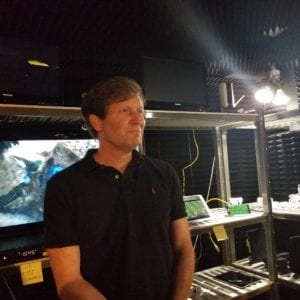
Sideways House’s entry is not your typical foyer. Designed for insulating the radio frequency test environment from the rest of Verizon’s Fios network management center, it is covered floor-to-ceiling,wall-to-wall in narrow, black foam pyramids of radiation-absorbant material, or RAM, that muffles both sound and radio waves — material more commonly found in an anechoic test chamber than in a residential home. The decor is appropos, though, as Sideways House is meant to be a bit of both. The entry-point is eerily quiet, with the only sound coming from the intermittent grind of one of the evolving turntables that hold test devices scattered throughout the space. Sideways House has 25 of the portable turntables, designed by a local high school robotics team coached by Sideways House’s lead engineer, Cooper said.
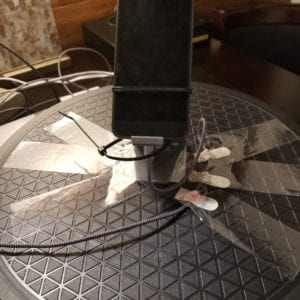
Cooper walks through one oddly wide, tall doorway and stops to point out that the reason it’s oversized is that it’s actually built to match the dimensions of a typical residential stairway. The walls and duct work in this area are all residential-grade — the walls, true to the “sideways-house” design, are built as if they were typical residential floors. Residential copper pipe threads through those walls, as does typical ductwork, some of it functional — no small feat in a commercial enterprise complex, Cooper points out, and a design feature that meant a lot of extra planning and permissions during the construction phase
One vertical wall section is covered floor-to-ceiling in tile flooring, next to another section with wood flooring in order to test the influence of common flooring types on signal propagation. The ceilings above sport more of the black foam-pyramid lining, so that signals travel between the rooms horizontally rather than vertically. The long, broad hallways are peppered with turntables ready to hold devices, side tables and the occasional television.
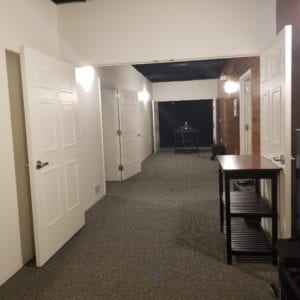
Sideways House is a bit of a maze, with doorways leading from room to room — including that tidily furnished vertically hanging bedroom. The many doorways, Cooper explains, can be opened or closed depending on the desired environment: open, the environment mimics the sideways-house for which it was named. Close various doors, and Sideways House becomes more like Sideways Apartments, so that Verizon can get insights into performance in a multi-dwelling unit space.
Sideways House isn’t the only test chamber on-site, although it’s certainly the largest and most complex. Down another long hallway with dozens of cables running on a suspended platform overhead, Cooper walks through a lab filled with rows of testing stations (only a few of which are occupied on a recent visit) to the right and to the left, a row of ceiling-high steel boxes — smaller, more typical anaechoic chambers that are used for testing APs and other devices at various points in the development and certification process. A sign outlines Verizon’s five stages of testing: hardware qualification, when a device is tested for standards conformance; stress and performance testing to ensure stability; feature and function testing to make sure the device integrates with Verizon systems; client interoperability testing focused on customer experience; and over-the-air testing. Inside one of the anechoic chambers, stress testing of a future Fios update is underway. Tall plastic racks line the walls, holding test equipment and a variety of devices. More than a dozen smartphones and laptops flash streaming video and apps across their screens, and traffic from around 20 additional devices is being simulated to see just how much load a single home gateway in a corner can handle.
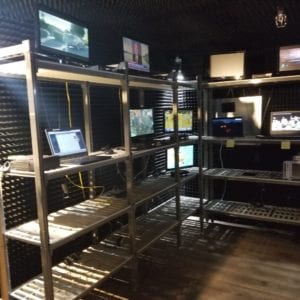
Verizon prefers to get its hands on equipment as early in the design process as possible, Cooper said, so that it can conduct testing and provide feedback that will influence design changes and fixes.
Analytics also plays an important part of how Verizon is approaching home Wi-Fi, Cooper said. Verizon has developed its own application for technicians in order to provide better insights into the RF environment and optimize installation. As important as Wi-Fi connectivity in the home is, he said, customers still tend to think first about where they want to place (or hide) a router based on aesthetics, with coverage as an afterthought — until something goes wrong.
“In the past, someone calls in and says their internet broke, and you go out and maybe replace some equipment. Now, [technicians] have analytics, they have tools and even better knowledge,” Cooper said.
The work on Fios residential Wi-Fi is also being leveraged to inform Verizon’s ongoing 5G fixed wireless access trials and eventual roll-out — since after all, FWA is basically a different way to connect a residential Wi-Fi router for a home network, and that’s something that Sideways House can be used to assess.
“We’re lending what we’ve learned to the fixed 5G deployment,” Cooper said.

